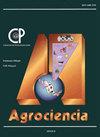一种可食用的蜡烛蜡基涂层的潜在用途,以延长百香果的保质期
IF 0.5
4区 农林科学
Q4 AGRICULTURE, MULTIDISCIPLINARY
引用次数: 0
摘要
百香果(Passiflora edulis f. flavicarpa Degener)由于其保质期短而不被广泛交易。可食用涂层可用于延长水果的采后寿命。本研究的目的是开发一种小蜡烛蜡基涂层(Euphorbia antisyphilitica Zucc)用于保存百香果。三种涂层配方(C1, C2和C3)由果胶,甘油和小烛台蜡制成,并浸渍应用。在两种储存条件下:室温(32°C/6天)和冷藏(6.6°C/32天),用体重减轻和外观变化来评估保质期。两种贮藏条件下未包衣的果实作为对照。此外,还对涂层进行了理化表征。室温下涂有涂层的水果与对照组相比,重量保持有所改善,但外观没有变化。在冷藏的水果中,只有C2的重量比对照减少了,而C3保持了更好的外观。在涂层表征方面,C3的含水率和厚度最低。C1的密度值最高,而C1的水蒸气渗透率(TPVA)值也最高。C2涂层对果实保鲜时间较长,且TPVA值最低,这与降低果实失重有关。本文章由计算机程序翻译,如有差异,请以英文原文为准。
POTENTIAL USE OF AN EDIBLE CANDELILLA WAX-BASED COATING TO EXTEND THE SHELF LIFE OF PASSION FRUIT
Passion fruit (Passiflora edulis f. flavicarpa Degener) is not widely traded due to its short shelf life. Edible coatings can be used to extend the postharvest life of fruits. The objective of this study was to develop a candelilla wax-based coating (Euphorbia antisyphilitica Zucc) for the preservation of passion fruit. Three coating formulations (C1, C2, and C3) were made with pectin, glycerol, and candelilla wax and applied by immersion. Weight loss and changes in physical appearance were used to assess shelf life under two storage conditions: room temperature (32 °C/6 days) and refrigeration (6.6 °C/32 days). Uncoated fruit in both storage conditions served as controls. Furthermore, a physicochemical characterization of the coatings was performed. Coated fruit at room temperature showed an improvement in weight retention compared to controls, but no differences in physical appearance were observed. In fruits stored under refrigeration, only C2 had less weight loss compared to the control, while C3 maintained a better physical appearance. In terms of coating characterization, C3 presented the lowest moisture content and thickness. C1 obtained the highest density value, while C1 also had the highest water vapor permeability rate (TPVA) value. The application of the C2 coating was effective in preserving the fruit for a longer period of time, and this coating has the lowest TPVA value, which is related to the decrease in weight loss in the fruit.
求助全文
通过发布文献求助,成功后即可免费获取论文全文。
去求助
来源期刊

Agrociencia
农林科学-农业综合
CiteScore
0.50
自引率
33.30%
发文量
51
审稿时长
18-36 weeks
期刊介绍:
AGROCIENCIA is a scientific journal created and sponsored by the Colegio de Postgraduados. Its main objective is the publication and diffusion of agricultural, animal and forestry sciences research results from mexican and foreign scientists. All contributions are peer reviewed. Starting in the year 2000, AGROCIENCIA became a bimonthly and fully bilingual journal (Spanish and English versions in the same issue). Since 2007 appears every month and a half (eight issues per year). In addition to the printed issues, the full content is available in electronic format.
 求助内容:
求助内容: 应助结果提醒方式:
应助结果提醒方式:


